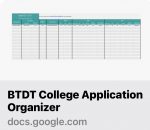

Applying to Colleges and Finding Scholarships
College isn’t cheap and transitioning from homeschool to a four-year university may seem overwhelming and you probably have a lot of questions but don’t worry! We’re going to walk you through the application process and the best way to get some extra cash to pay for it all!
-How do I choose colleges to apply to?
-How do I begin the application process?
-Where do I find scholarships?

Episode 036:
TWO WAYS TO LISTEN TO THIS EPISODE:
1. Click PLAY Button Above ^^ to listen here.
2. OR Listen on your favorite podcast platform:
Scroll down for this week’s FREEBIE:
Editable College Application Organizer (Google Doc)
Brand New to Homeschooling?
GETTING START PAGE >>
Kindergarten Page >>
High School Series >>
Show Notes
We’ve talked a lot already about designing your 4-year plan and mapping out future goals. Your teenager may be opting for a future in the military, trade school, entrepreneurship, or the workforce and maybe college is not part of their plan. Or maybe they are considering going to community college and then transferring to a university which can often be a huge savings for families choosing this route.
They may even be considering a gap year. Several students we know chose this pathway. For some, it was because of the pandemic, for others, their students possibly needed time to save up money for future schooling. Others chose service programs like Americorps. Another student friend is doing a foreign language program abroad. There are so many options. But for those who are college bound, thinking ahead to college can be an overwhelming prospect.
How many applications?
While there is no exact formula or a perfect number of schools to submit your applications to, most students apply to 4-8 universities.
Safety School (2-3)
Sometimes called “back-up schools,” are schools you’re practically guaranteed admission. In general, safety schools have high acceptance rates.
If you are new to homeschooling, be sure to check out our Getting Started Page where we step you through the entire process.
Target School (2-3)
Sometimes called ”match school” your grades and test scores should fall into the accepted range of the school’s most recently admitted class. While acceptance isn’t guaranteed, you should have a 40-60% chance of getting accepted.
Reach School (1-3)
If your grades and academic credentials fall in the lower range or below a school’s average from the previous year’s accepted students, then that school would be considered a “reach school” (also called a Dream School).
How do I choose colleges to apply to? (6:46)
Choosing a college to apply to can be really exciting for your teen but it can also be a challenging decision. It’s important to remember that this is their path, and they are the ones that are ultimately making the decision. Your job is to guide them and help them through this process. So, talk to them and have open discussions and dialogue. To help you through this process, we’ve put together some steps to help narrow this down for them.
- Identify priorities: you’re going to be making a list of your priorities to guide your decision-making. Think about what factors are important to them in choosing a college. Consider things like academic programs, location (maybe they want to live in a sunny, warm state?), campus culture, extracurricular activities, size, cost (obviously, this is a big one for a lot of families!), and any other criteria that matter to you in a college.
- Research colleges: Look for colleges that are going to align with the priorities you laid out. You’ll want to consider factors like academic reputation, majors and programs offered, faculty expertise, campus facilities, student organizations. Books like Fiske Guide to Colleges and the Princeton Review: The Best 388 Colleges are a great way to see ratings and criteria. Scroll down to view our list of college websites and resources.


- Tour some campuses: If it’s feasible, try to tour the campuses of the colleges you’re interested in. Visiting a campus will provide insights into the atmosphere, campus life, facilities, and overall vibe of the institution. Many offer information sessions so take advantage of those. You can take the official campus tour, and talk to current students and faculty, and just explore the surrounding area. Often the tour guides and people working in the visitor center are students themselves and love to share about their experiences.If you don’t know where to start with this, visit a few of the college campuses that are closest to you, even if your kiddo is pretty sure they don’t want to go there. You definitely want them to have an idea of what to expect and be able to have a baseline for that. Even though you can do some of these tours online, it pales in comparison to being on campus and taking it all in.
- Seek guidance and advice: Talk to friends, family members and homeschool parents who can offer insights into the college selection process. They may have recommendations based on your academic strengths, interests, and career goals. You can get advice from people you know who may have attended or have knowledge about different colleges or a college on your list. Reach out to current students or alumni of the colleges you’re interested in. Ask questions about their experiences, campus life, academic rigor, and career outcomes. Their perspectives can provide valuable insights that might not be available through official sources. Many out of state schools have local or regional representatives or alumni groups. We met with a traveling advisor about one school, and we attended an alumni event for another school and it’s a great way to get a great vibe. You can also join the school’s social media pages for information. Look at what kinds of clubs and activities they offer.
- Consider financial factors: College can be a significant investment, so it’s essential to consider the financial implications. Evaluate the cost of tuition, fees, room and board, and other expenses. Research scholarships, grants, and financial aid opportunities offered by each college. Consider your financial situation and weigh the affordability of each institution. Have an honest heart to heart with your children about yours/their financial situation so they understand from the get-go what their options truly are.
- Review admission requirements: it’s essential to meet the admission requirements for each college you’re considering. We talked about this in a couple of our other high school series episodes. Specifically checking with the college admissions to ensure that your 4-year high school plan will meet those. Check the necessary standardized test scores (SAT, ACT, and others.), GPA requirements, prerequisite courses, and any other criteria. It’s also important to have a realistic understanding of your chances of admission to each institution. Definitely look to see if they have special requirements for homeschoolers. Also consider whether you have a solid chance at this school. Many schools charge to apply and that adds up quickly. An average student might not want to waste time applying to a college with a 7% acceptance rate.
- Consider your long-term goals: Think about your future career aspirations and how each college can contribute to your academic and professional growth. Look for colleges with strong programs and resources in your area of interest. Consider internship opportunities, research facilities, and alumni networks that can help you advance your career. If your child knows what they want to major in already, you can research what schools are ranked highly for that.
- Trust your instincts: After conducting thorough research and gathering information, trust your instincts and listen to your gut feeling. Reflect on which college resonates with you the most and aligns with your goals, values, and aspirations.
Remember that the college application process often involves applying to multiple institutions to increase your options. Be sure to meet application deadlines, submit required documents, and give yourself enough time to complete the process for each college you choose. Good luck!
How do I begin the application process? (16:56)
The college application process can be stressful with numerous tasks and decisions involved. However, with some planning, you can navigate the process more smoothly. We’ve laid out some strategies and tips to help you manage everything, including your stress level during this time:
- Start Early: Begin your preparations well in advance. Give yourself ample time to research colleges, understand all those admission requirements, and gather all the necessary documents. Our high school documents episode in this series lays all that out for you. Starting early will allow you to spread out the workload and avoid that last-minute stress. Many people recommend things like using essay prompts for writing assignments during the summer or late junior year so that you already have things prepared for application season. You can also get on Common App a couple years before you actually need to.
- Break It Down: Divide the application process into smaller, manageable tasks. Create a timeline or checklist with specific deadlines for each task, such as researching schools, writing essays, gathering recommendation letters, and completing all the forms. Breaking down the process will make it feel less overwhelming. Make a spreadsheet with all the schools and all of their dates so we could figure out which things need to go where. There’s a lot of information in a lot of places so it can get really overwhelming. Keep all your application materials, deadlines, and important documents well-organized. And definitely utilize those digital tools, like Trello. Staying organized is going to give you a sense of control and reduce anxiety.
TRELLO is a free app that keeps me organized: https://trello.com
- Practice Self-Care: Make sure to take care of your physical and mental well-being during this period. Get enough sleep, eat nutritious meals, and engage in regular exercise or activities that help you relax and unwind. Taking breaks and pursuing hobbies or interests can help alleviate stress and maintain a healthy balance.
- Manage Expectations: Remember that the college application process is competitive, and rejection is a possibility. While it’s essential to aim high and work hard, it’s also important to be realistic and have backup options. This is one of the reasons that we recommend applying to safety, target, and reach schools. Keep in mind that there are SO MANY colleges where you can receive an excellent education and have a fulfilling college experience.
- Seek Support: Reach out to parents or homeschooling forums for guidance and support. They can provide valuable advice, or review your application materials, and help you stay organized. Sometimes, simply sharing your thoughts and worries can provide relief. This is where we all really feel the stress because it all reflects on us as the homeschool parent. If they were in school and somehow everything went downhill, we can blame that, but the pressure and focus is 100% on us! (It isn’t really, but it sure feels like it!) Remember, you are not alone in this process, and many others, including both of us, have successfully navigated college applications. Reach out for support when needed, and stay organized.
How do I pay for college? (25:43)
There are several ways people pay for college, and the methods can vary depending on personal circumstances and the country’s education system. Here are some common ways people finance their college education:
It’s worth noting that the availability and specific details of these options can vary by country, educational institution, and individual circumstances. It’s advisable to research and consult with financial aid offices or student advisors at each specific college or university for more detailed information about financing options.
The first place people typically look to help with college is through scholarships and the biggest are often offered through the schools themselves. It’s important to know that VERY few graduates get full ride scholarships. The National Center for Education Statistics study entitled National Postsecondary Student Aid Study found that even though 70% of undergraduates received some financial aid, only .2% received $25,000 or more.
- Personal savings: Some individuals or families save money specifically for college expenses. This could involve setting aside a portion of their income or making long-term investments like a 529 to fund their education.
- Scholarships: Scholarships are financial awards given to students based on various criteria such as academic achievements, athletic abilities, or specific talents.
- Grants: Grants are similar but are usually need-based. These do not need to be repaid, making them highly desirable sources of funding. The FAFSA (Free Application for Federal Student Aid) is completed by current and prospective college students in the US to determine their eligibility for aid. The FAFSA is different from the CSS Profile, which is also required by some colleges.
Federal Pell Grants: https://studentaid.gov/understand-aid/types/grants/pell
- Student loans: Many students rely on loans to cover their college expenses. These loans can be obtained from government organizations or private lenders. Students are required to repay these loans after completing their education, typically with interest.
- Work-study programs: Some colleges and universities offer work-study programs that provide part-time employment opportunities to students. Through these programs, students can earn money to help cover their educational costs. So many of these opportunities keep the college running and at the same time help students pay for their education.
- Parental support: Some parents (or other family members) financially support their children’s college education by covering some, or all, of the expenses. This can be through savings, income, or borrowing on behalf of their child.
- Financial aid: Colleges and universities may offer financial aid packages that include a combination of scholarships, grants, loans, and work-study opportunities. Financial aid is typically determined based on factors like family income, assets, and the cost of attendance.
- Employer assistance: Some companies or organizations provide tuition reimbursement or educational assistance programs to their employees. This benefit allows individuals to pursue higher education while working and reduces the financial burden.
- Military Grants & Scholarships: There are several paths to financing college that come from previous service in the military or from a parent or siblings service.
Military Grants and Scholarships
If you’re an active servicemember, Veteran or if you’re a child of a military family, there are several financial scholarships and grants available to support you in covering your college expenses. These opportunities are designed to assist you in pursuing higher education and achieving your academic goals.
These are federal government programs, like the Federal Supplemental Educational Opportunity Grant, that can provide assistance. Additionally, nonprofit veterans’ service organizations, such as the Pat Tillman Foundation, offer scholarships and grants tailored to support individuals like yourself. Some educational institutions also offer direct financial aid options.
Scholarship Scams
Unfortunately, there are numerous scams making the rounds seeking to take advantage of unsuspecting students. Fraudsters prey on needy scholarship applicants and attempt to steal money, banking details, personal information, and more. Thankfully, there are ways to spot these schemes so you can avoid wasting your time and use it to focus on real scholarship applications.
Here are 8 tips on spotting and avoiding scholarship scams:
- Question if it’s too good to be true
- Be wary of a sense of urgency
- The promise of exclusive information should be a red flag
- Question money-back guarantees
- Ignore claims of unclaimed funds
- Watch out for claims of affiliation with a reputable organization
- Learn to spot phishing emails and websites
- Don’t hand over personal or banking information
Where do I find college scholarships?
It’s important not to miss the joys of homeschooling during the high school years because you’re so stressed about scholarships. Finding scholarships for college can be a time-consuming but worthwhile endeavor.
Scholarships in Summary
We have listed some websites below for reference, but we highly recommend you don’t waste too much time but instead get this book: the Ultimate Scholarship Book. It’s updated twice per year. It has several thousand scholarship listings, and the opening chapters are gold for the advice they give. There are 13 indexes in the back so you can search by race, major and disability status separately.

For local scholarships, I recommend that you look up your community foundation. Most are titled (your city/region) community foundation. Most have a scholarship portal where you can do a general app.
Professional organizations are also a good way to go. Many will probably be in the book, but you can google for them
Law firms also provide scholarships. No, you don’t have to be a law student to apply. Most just want you to write an essay on a topic that is relevant to their practice (i.e. importance of not drinking and driving)
See if your college of choice financial aid department has a scholarship portal.
Note: As a best practice, keep a copy of all the essays you write and reuse them for later. You would be amazed at how many prompts are the same/similar.
- Check with the College: Start by exploring scholarship opportunities offered directly by the colleges or universities you’re considering. Many institutions have their own scholarships, grants, or financial aid programs available to incoming students. Visit their financial aid office or check their website for information on scholarships specific to their institution.
- Use Scholarship Search Engines: Online scholarship search engines can be valuable resources for finding scholarships that match your profile. Websites like Fastweb, Scholarships.com, and College Board’s Scholarship Search offer comprehensive databases where you can search for scholarships based on your interests, background, field of study, or other criteria.
- Research Local Scholarships: Investigate scholarships offered by local organizations, community foundations, businesses, or nonprofit groups in your area. These scholarships may be less competitive than national ones, as they are often limited to students from specific regions or schools. Community organizations are great resources. For example, 4H and even our local orthodontist have a great scholarship! Local libraries are usually a great resource for information on these opportunities.
- Explore Professional Organizations: Many professional associations, industry-specific organizations, and trade groups offer scholarships to students pursuing careers in their respective fields. Research organizations related to your intended major or career path and check their websites for scholarship opportunities.
- Utilize Social Networks: Inform your network of family, friends, and mentors that you’re seeking scholarships for college. They may be aware of specific opportunities or connections that could assist you in your search. Additionally, consider joining online forums, groups, or communities focused on college scholarships to connect with others who can share resources or advice.
- Employer Programs: If your teenager has a job, check with their employer or parent’s employer and inquire whether your employer or parent’s employer provides scholarships for employees or their children. Many companies offer scholarships as part of their benefits packages or corporate social responsibility initiatives.
- Research National Scholarships: Look for national scholarships that are open to students across the country. Organizations like the Gates Millennium Scholars Program, Coca-Cola Scholars Foundation, or the National Merit Scholarship Program offer prestigious scholarships to deserving students. Research their eligibility criteria and application processes.
The Gates Millennium Scholars (GMS) program, now known as the Gates Scholarship, is a prestigious scholarship program funded by the Bill and Melinda Gates Foundation. The program provides scholarships to outstanding minority students pursuing undergraduate degrees. The website serves as the platform for the application process and provides information about the scholarship.
The Coca-Cola Scholars Foundation is widely recognized for its prestigious scholarship program and the significant financial support it provides to selected scholars. The scholarship covers a substantial portion of educational expenses, including tuition, fees, books, and room and board.
The National Merit Scholarship Program is a prestigious scholarship program that recognizes and awards scholarships to high-performing students based on their PSAT/NMSQT scores. The website has information about the program, scholarship opportunities, and the selection process. It provides comprehensive details on eligibility requirements, application deadlines, and steps for becoming a National Merit Scholar.
- Scholarship Books: Check with scholarship directories and books. My favorite “The Ultimate Scholarship Book” provides extensive lists and details on various scholarship opportunities. This book is so thorough!
Favorite College Website and Apps
Big Future is an online platform provided by College Board, offering resources and tools to help students explore and plan for their college education. It provides information on colleges, majors, scholarships, and financial aid, allowing students to search for schools based on their preferences and compare them. Additionally, it offers career exploration tools and guidance for test preparation, making it a comprehensive resource for college-bound students.
Cappex is a reputable platform that offers college and scholarship search services for students, including new graduates. It provides a comprehensive database of colleges and universities, as well as scholarship opportunities.
College Navigator, provided by the National Center for Education Statistics (NCES), is a widely regarded and reliable platform for exploring colleges and universities in the United States. It offers comprehensive data on institutions, including information on programs, admissions, financial aid, and more. The best part is that College Navigator is completely free to use, making it an excellent resource for students, parents, and educators seeking detailed information about colleges without any associated costs.
Unigo is a popular platform that provides college reviews, scholarship information, and resources for students exploring higher education options. While Unigo offers free access to a range of college-related content, they also have a premium subscription service.
RaiseMe is an online platform that allows high school students to earn micro-scholarships from participating colleges based on their achievements and activities. It can be a helpful tool for students looking to earn scholarships and explore college options.
Scholly Search is a popular scholarship search platform that helps students find relevant scholarship opportunities. It offers a user-friendly interface and personalized scholarship matches based on the student’s profile. While Scholly Search does have a subscription-based service called Scholly Premium, which provides additional features and benefits, the platform also offers a free version that allows users to access and apply for scholarships without any cost.
HBCU Hub is a comprehensive online platform that provides information and resources specifically tailored to Historically Black Colleges and Universities (HBCUs). It offers a range of features, including college profiles, scholarship opportunities, virtual campus tours, and a community forum. HBCU Hub is free to use.
College Scholarship Calculator from College Raptor
The basic features of College Raptor are available for free, allowing students to access important information about colleges and estimated costs without any cost. However, College Raptor also offers a premium version called College Raptor Premium, which provides additional features and services at a cost. The free version can still be beneficial for many students.
Scholarships.com is a widely recognized and free search platform that provides access to a large database of scholarship opportunities for students. It offers a user-friendly interface and allows students to search for scholarships based on various criteria such as academic achievements, interests, demographics, and more.
Fastweb offers a comprehensive database of scholarships from different sources, including corporations, foundations, and educational institutions. Fastweb is free to use.
Niche provides a wide range of information and resources for students and families navigating the college search and selection process. It offers college rankings, reviews, and data on various aspects of colleges and universities, including academics, campus life, and student experiences. Niche is free to use but also offers some premium features for a cost.
CareerOneStop is a highly regarded website sponsored by the U.S. Department of Labor, Employment and Training Administration. It offers a wealth of resources for career exploration, job search, training programs, and employment information. Completely free to use, it provides users with access to tools like career assessments, occupation profiles, salary data, job search resources, and training program information at no cost.
Things to know when evaluating financial aid offers
1) Make a spreadsheet so you can compare various aspects of the award. Scroll down to download the one we created for FREE!
2) How much grant money vs. loan money is each school offering?
3) Are the grants renewable in subsequent years? If so, are there GPA requirements, major requirements, academic progress requirements?
4) Will the grants received be the same amount in subsequent years? Be aware that some schools give the most grant money the first year with reduced amounts in years to follow.
5) What kind of loans are offered? Subsidized are best. Beware of parent plus loans, which require families to have good credit, and which can cost double the loan amount in interest.
6) If a student or parent is considering taking out loans, what will repayment look like? You can estimate this by using the Loan Simulator at studentaid.gov.
7) If work study is listed, be aware that work study is dependent on the student finding an acceptable on-campus job that fits their schedule. A work study job is not guaranteed.
FAFSA (Free Application for Federal Student Aid) is a crucial resource for students seeking financial assistance for higher education. It is a form that students must complete to determine their eligibility for federal and state financial aid programs, including grants, loans, and work-study opportunities. FAFSA helps assess a student’s financial need and enables colleges and universities to determine their financial aid package. It is important because it provides access to various forms of financial aid, making college more affordable and accessible for millions of students each year. FAFSA deadlines vary, so be sure to submit the application as early as possible to maximize aid opportunities.
Remember to carefully review the eligibility requirements, deadlines, and application processes for each scholarship you consider. Pay attention to any essays, recommendations, or additional materials required, and make sure to submit your applications on time. Keep track of the scholarships you apply for and maintain a calendar to stay organized throughout the process. Lastly, be persistent and try not to get discouraged if you don’t receive every scholarship you apply for. Scholarships are really competitive, but the more you apply to, you increase your chances of securing financial assistance.






